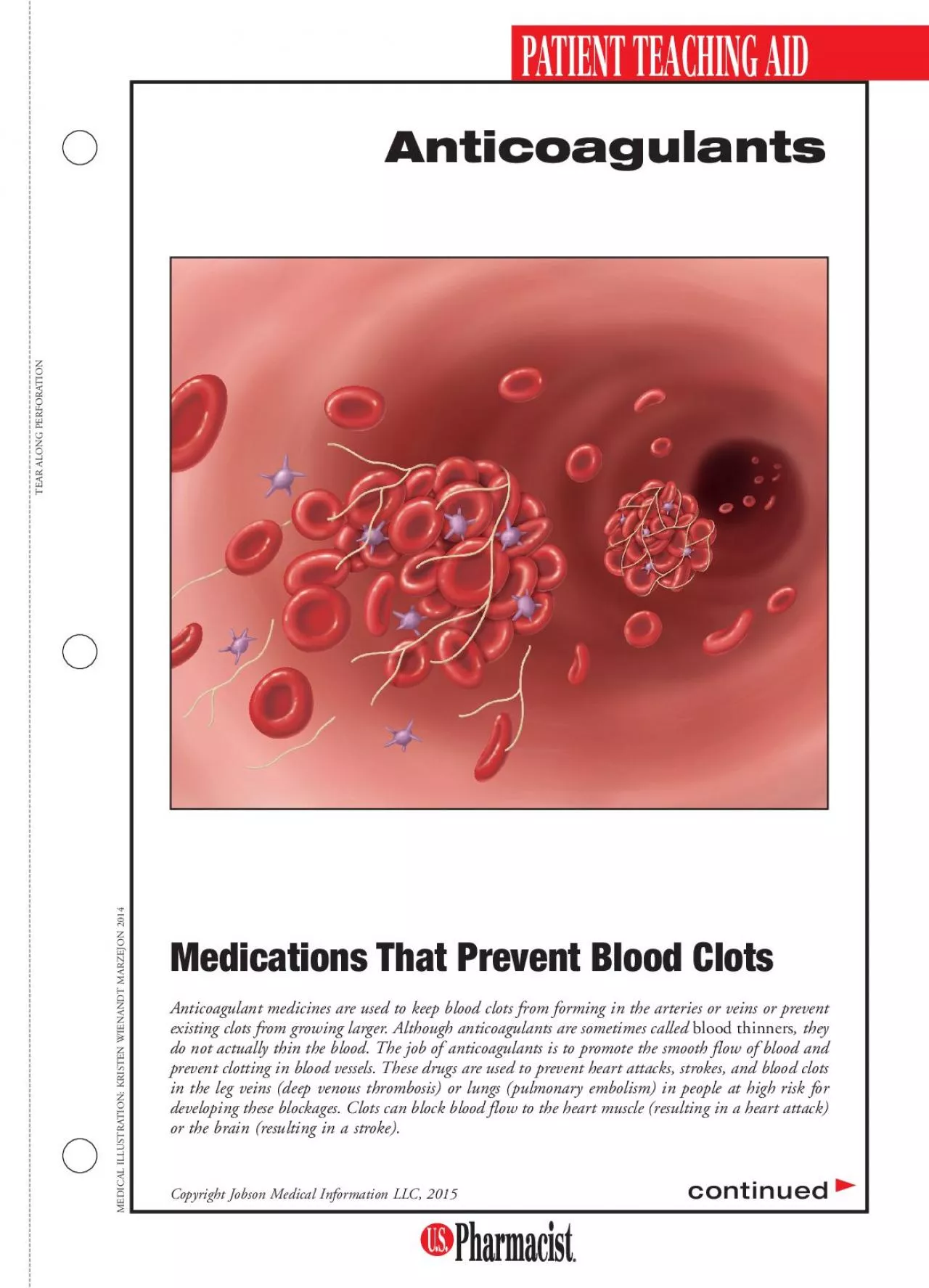

existing clots from growing larger Although anticoagulants are sometimes called blood thinners they do not actually thin the blood The job of anticoagulants is to promote the smooth flow of bloo ID: 943858
Download Pdf The PPT/PDF document "Anticoagulant medicines are used to keep..." is the property of its rightful owner. Permission is granted to download and print the materials on this web site for personal, non-commercial use only, and to display it on your personal computer provided you do not modify the materials and that you retain all copyright notices contained in the materials. By downloading content from our website, you accept the terms of this agreement.
Anticoagulant medicines are used to keep blood clots from forming in the arteries or veins or prevent existing clots from growing larger. Although anticoagulants are sometimes called blood thinners , they do not actually thin the blood. The job of anticoagulants is to promote the smooth flow of blood and prevent clotting in blood vessels. These drugs are used to prevent heart attacks, strokes, and blood clots in the leg veins (deep venous thrombosis) or lungs (pulmonary embolism) in people at high risk for developing these blockages. Clots can block blood flow to the heart muscle (resulting in a heart attack) or the brain (resulting in a stroke). Anticoagulants Medications That Prevent Blood Clots MEDICALILLUSTRATION: KRISTEN WIENANDT MARZEJON 2014 PATIENTTEACHINGAID TEARALONGPERFORATION Copyright Jobson Medical Information LLC, 2015 continued There are several kinds of anticoagulants. The main types are warfarin, heparins, factor Xa inhibitors, and thrombin inhibi - tors. These agents work in different ways to keep blood from clotting. They do not break up blood clots that have already formed, but prevent new clots from forming or growing larger. Patients for whom anticoagulants are prescribed include those with heart disease, clotting problems, a history of strokes, recent surgery, or blood vessel blockages or inflammation that cannot be treated using other therapies. Administration of Anticoagulants Anticoagulants are given either in oral form or by injection. Most injectable forms are administered in the hospital. The type of anticoagulant prescribed depends upon the condition being prevented. Oral anticoagulants are used to ward off clot formation in patients with heart-valve replacement, atrial fibrillation, or other heart diseases, and in patients with phlebitis (inflammation of a vein). Injectable anticoagulants are often used to prevent blood clots before or after major surgery, such as knee or hip replacement. Anticoagulants are powerful medications, and the dosage must be monitored closely. If the dosage is too high, bleeding can result, but if the dosage is too low, blood clots can occur. Patients who are taking anticoagulants on a long-term basis are required to have regula
r prothrombin time (PT) blood testing. The PT test measures a value of clotting time that indicates whether the dos - age of anticoagulant should be adjusted. Frequent blood tests are not required with some newer types of anticoagulants, however. Side Effects Common side effects of anticoagulants include stomach upset, loss of appetite, bloating, and diar - rhea. If the dosage is too high, blood may be seen in the urine or stool or around the gums, or frequent nosebleeds may occur. These side effects, as well as easy bruising, dark stools, itching or hives, vomiting of blood, or back pain, should be reported to a healthcare professional immediately. Many foods and drugs can increase or decrease the action of anticoagulants, especially warfarin. Patients should be aware of the foods that can interfere with anticoagulants and should avoid eat - ing them often or in large quantities. Newer agents, however, have fewer dietary restrictions. Patients should inform their pharmacist and doctors that they are taking an anticoagulant. Precautions must be taken prior to certain medical and dental procedures in patients taking anticoagulants. Many commonly used prescription and OTC medicines, such as antibiotics and pain relievers, can affect the action of anticoagulants. Vitamin K, vitamin E, fish oil, herbal products, smoking, and alcohol can also affect anticoagulant activity. Proper Usage Anticoagulants are potent medications, and they should be taken exactly as directed. Each time the anticoagulant prescription is filled, the pharmacist should check to make sure that the dosage of the pills is correct. Anticoagulants should be taken at the same time each day, and patients should understand what to do if they miss a dose. Brand-name and generic forms of oral antico - agulants are not always identical in their effect, especially between countries. For this reason, it is extremely important to take along a supply of anticoagulant medication when traveling abroad. Prescribed for Patients at High Risk for Developing Blood Clots Rather than breaking up blood clots that have already formed, anticoagulants prevent new clots from forming or keep existing clots from increasing in size. PATIENTTEACHINGAID